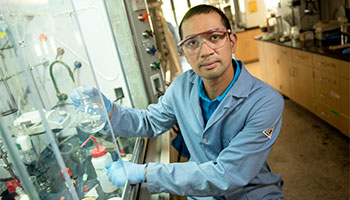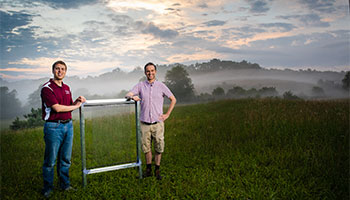Out of the lab, into the market
Virginia Tech debuts tool to turn innovation into businesses
Tim Thornton //October 27, 2020//
Out of the lab, into the market
Virginia Tech debuts tool to turn innovation into businesses
Tim Thornton //October 27, 2020//
Virginia Tech was born to promote business.
The 1862 Morrill Act, which created land-grant universities including Virginia Tech, requires such universities to “teach such branches of learning as are related to … agriculture and the mechanical arts … to promote the liberal and practical education of the industrial classes.”
Tech and every other university that receives federal research funding became more enmeshed in commerce in 1980, when the Bayh-Dole Act required those universities to attempt to commercialize research and share resulting revenues with inventors. Virginia Tech’s marketplace bond strengthened again in 2017, when Brandy Salmon, vice president for innovation and partnerships, joined the university and created Link+License+Launch, the university’s “center for industrial partnerships.”
“It wasn’t that we didn’t do industry partnership work or tech transfer” before she arrived, Salmon says. Her task was to “create a more deliberate and integrated approach.”
Last fiscal year, Link+License+Launch was involved with 20 license and option deals and six startup deals. It brought in more than $1.4 million in direct licensing revenue.
The initiative’s “Link” component serves companies that already have a relationship with the university, as well as companies the university wants to cultivate. “License,” as its name implies, focuses on licensing technology and “Launch” is all about startups.

“Working with industry is not for all faculty and not for all programs,” Salmon admits, “but for those that have an applied nature or there’s technology or R&D or even talent that has an external view [or] opportunity, then we really support that. … To me, Link, License and Launch is really the launch pad for us continuing to build our support for our innovation ecosystem. … It’s really about providing a service to our constituents.”
Any university’s mission is threefold: teaching, research and impact, says Mark Mondry, associate director of Launch.
“That can be impact on the economy. It can be impact on humanity. It could be anything in between,” he says. “But this is mostly about, how do we use the assets in the first two to leverage and amplify the third mission of societal and economic impact?”
Mondry oversees the university’s latest tool in the drive to leverage and amplify and impact: proof of concept (POC) grants. The grants, which offer up to $50,000 to Virginia Tech researchers, are meant to help innovators bridge the distance between idea and product. Most of Virginia Tech’s $531 million in research funding comes from the federal government. And much of Tech’s research could be potentially valuable in societal and economic terms. But commercializing it requires money. Uncertainty and risk, which are abundant in early research and development stages, may repel private funding.
“Uncertainty both in the technology — Can we make it at scale? Does it work? Does it do the kind of things that we hope it will do? — but also around the market,” Mondry says. “Is the market looking for what this technology offers? Do we know who might be interested in it and why? Public money is best positioned to fill that gap, because the private money is willing to wait.”
While private money waits to see how things develop, innovations are left with a funding gap, a potentially fatal condition no matter how good an idea may be.
“The goal of the POC funding is quite simple,” Mondry says. “The goal is to have awardees succeed in capturing their next round of commercialization funding.”
Ready for the big time
A POC grant may fund experiments, as it will with a multiple sclerosis-fighting drug being developed by Virginia Tech chemistry Professor Webster Santos and University of Virginia Professor and Vice Chair of Pharmacology Kevin Lynch. The results are promising so far, but the team needs to validate its results with larger-scale experiments. If those experiments work, Santos says, “Bigger companies will know who we are and hopefully they’d want to partner with us. And so we’d go from a $15 million company to a $150 million company and, if it all works out, it’s a $1 billion company.”

Ed Fox, a Virginia Tech professor of computer science, already has a company that funded his development of software to summarize legal depositions and other long and complicated documents. A POC grant will help get the software into trials by the people intended to be its end users.
“We’ve been at it for more than three years, but to get this into the commercial world, it takes more than just doing the research. It takes understanding the business world and so on,” Fox says. “There’s a bit of a gap between proving something and publishing about it and being able to show the method works … better than other techniques and turning it into something that will be appealing in the commercial sector.”
John Robertson, a Virginia Tech professor of biomedical engineering and mechanics, is in a similar place. His team is using laser energy to analyze urine. Their diagnostic method can quickly and accurately detect indications of all sorts of illnesses, but they need to build a sturdy prototype that will perform the tests in batches and then evaluate that prototype in real-life conditions.
“It’s not just sitting in the research labs and doing stuff that stays in Blacksburg,” Robertson says. “It’s really going out into the broader world and [taking] things that we invent and have them see the light of day and help people.”
Some researchers think about marketing potential long before their innovations are ready to be commercialized. Jonathan Boreyko, associate professor of mechanical engineering, and Brook Kennedy, associate professor in the Virginia Tech School of Architecture + Design, are developing a fog harp, an improvement on fog harvesters that use nets to capture potable water from fog. Boreyko and Kennedy’s design uses vertical wires, a much more efficient design.
Boreyko thought of calling the device a fog loom, since all the strings on the square-meter device are the same length. “I went down to my lab and asked all my international students,” Boreyko says, “‘Who here has heard of a harp?’ and they all raised their hands. Then I asked, ‘Who’s heard of a loom?’ and it was just crickets.”
So, fog harp it is.
“You can have the best invention or science breakthrough in the world, but if you can’t explain it in an exciting or intuitive way, then no one’s going to care,” Boreyko says. “‘Fog harp’ is more evocative than saying a fog net with the crosswires removed.”
Virginia Tech At A Glance
Founded
Virginia’s original land-grant university, Virginia Tech was known as Virginia Agricultural and Mechanical College when it was founded in 1872. Now, as Virginia Polytechnic Institute and State University, it is the state’s second-largest public university by enrollment.
Campus
Virginia Tech’s Blacksburg main campus stretches over 2,600 acres. Tech also has six regional presences statewide and a study-abroad campus in Switzerland. Currently, the university is building its $1 billion Innovation Campus in Alexandria, near the Amazon.com Inc. HQ2 site.
Enrollment*
Undergraduate: 29,300
Graduate: 6,414
First professional: 669
In-state: 21,536
International: 4,025
Minority: 8,411
Employees
Approximately 11,000 non-faculty staff members
Faculty 2,070 full- and part-time faculty;
51% are tenured
Tuition and fees, housing and financial aid*
Undergraduate in-state tuition and fees: $13,691
Undergraduate out-of-state tuition and fees: $32,835
Room and board and other fees: $9,342
Average financial aid awarded to full-time, in-state undergraduates seeking assistance in 2020-21: $8,588
*2019-20 enrollment data
a





















